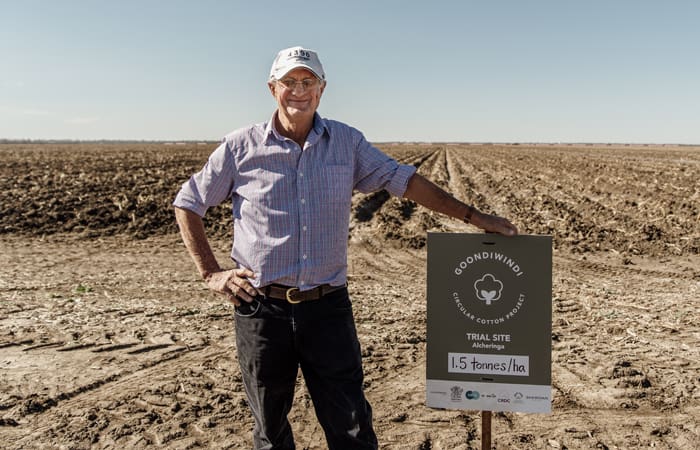
Goondiwindi cotton grower Sam Coulton at the trial site where end-of-life cotton textiles have been spread on cotton fields. Photo: Cotton Australia
A TRIAL conducted on a cotton farm at Goondiwindi has shown it is possible to divert large amounts of cotton textile waste at end of life from landfill with no harm done to soil health or cotton yields.
Project collaborators are confident that with a solid business plan and more research, returning shredded cotton products to cotton fields could soon offer benefits to soil health, and a scalable solution to the massive global problem of textile waste.
Under the guidance of circular economy specialists Coreo, the project involved the Queensland Government, Goondiwindi Cotton, Sheridan, Cotton Australia, Worn Up, and the Cotton Research and Development Corporation (CRDC), which supported involvement of University of New England soil scientist Oliver Knox.
“At the very least the trial showed that no harm was done to soil health, with microbial activity slightly increased and at least 2070kg of carbon dioxide equivalents mitigated through the breakdown of these garments in soil rather than landfill,” Dr Knox said.
“The trial diverted around 2 tonnes of textile waste from landfill with no negative impact on cotton planting, emergence, growth or harvest,” Dr Knox said.
“Soil-carbon levels remained stable, and the soil’s bugs responded well to the added cotton material.
“There also appeared to be no adverse effect from dyes and finishes, although more testing is needed on a wider range of chemicals to be absolutely sure of that.”
The 12-month trial was conducted on Sam Coulton’s farm, Alcheringa, and Mr Coulton said the cotton fields easily “swallowed up” the shredded cotton material, giving him confidence that this composting method has practical long-term potential.
“We spread the cotton textile waste a few months before cotton planting in June 2021 and by January and the middle of the season the cotton waste had all but disappeared, even at the rate of 50t to the hectare,” Mr Coulton said.
“I wouldn’t expect to see improvements in soil health or yield for at least five years, as the benefits need time to accumulate, but I was very encouraged that there was no detrimental impact on our soils.
“In the past, we’ve spread cotton gin trash on other parts of the farm, and have seen dramatic improvements in the moisture-holding capacity on these fields, so (we) would expect the same using shredded cotton waste.”
CRDC has committed to funding a three-year cotton textile-composting research project by the University of Newcastle that will further investigate the effects of dyes and finishes, and look at ways to pelletise cotton textiles so it can be spread on fields using existing farm machinery.
An expanded trial looks set to go ahead this season at Alcheringa, with Mr Coulton and his team keen to also develop a business case, purchase a shredder and potentially provide a model for employment in regional cotton communities.
The trial will extend in the coming season to Kensal Green, at Gunnedah in New South Wales, a farm owned by cotton grower Scott Morgan.
Sheridan, together with parent company Hanes Australasia, has committed to provide additional end-of-life cotton textiles and offcuts for the trial in 2022-23.
Hanes looks forward to finding ways to support the next phase of the trials and we hope that this paves the way for more innovative solutions to textile waste in our country,” Hanes Australia president Tanya Deans said.
Source: Cotton Australia

HAVE YOUR SAY